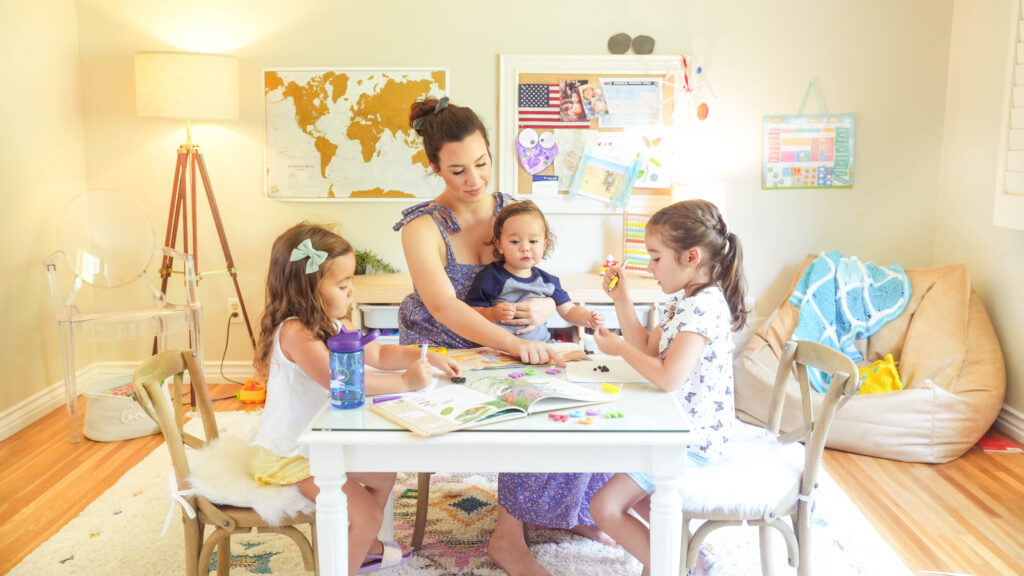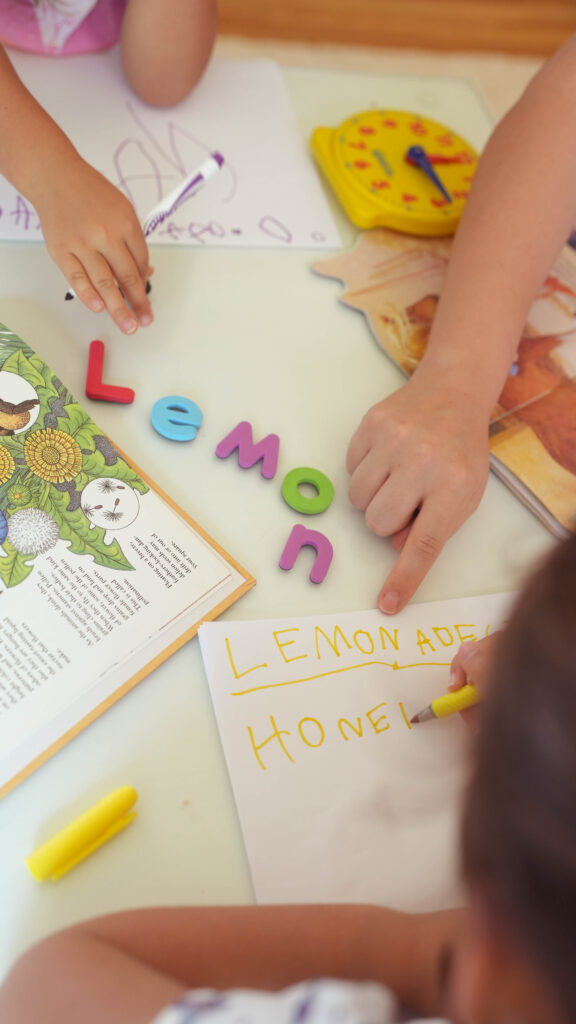Family, business, self development and more - we cover everything it takes to build a seven figure business at home, even with kids.
Get our free training!
This is about as real as it gets when it comes to family, wealth, and independence.
Listen to our podcast!
We're here to help you create a lasting family legacy, build generational wealth and develop the best version of your self in the pursuit of your own American Dream.
Hey, we're Hayley & Doug
Escape the Overconsumption Cycle: Tips for a More Intentional Life
When we first became parents, we told ourselves “We aren’t going to be THOSE parents with a house full of primary colored toys!” – that didn’t really go as planned.
Year after year we found ourselves spending time browsing the aisles of Target…or Home Goods…or really anywhere to “pass the time” with tiny toddlers especially in the heat of the summer months.
And so I’d come home with bags full of nonsense I didn’t need all of which I realized only AFTER baby #3 that…
I actually had to MANAGE that stuff! It doesn’t actually just sit there. As our kids became more mobile and more self sufficient the stuff in our house just started moving…everywhere.
Toys perfectly put away in labeled bins (see below for an old photo)? Dumped on the floor IN ANOTHER ROOM a day later.

Bought a cute new princess cup from Target? It’s in the…garage???
New dresses/accessories for the kids!? They change 10x a day and it’s all strewn about their room.
The stuff just seemed to magically “walk” everywhere!
So we started to get radical and stripped it wayyyy down after baby #3 and I’m still culling daily with four kids.
One cup per person. If it’s dirty…well then, we are forced to wash it;)
One plate. Same story. *We keep a set for guests!
Minimizing the kitchen area made the biggest impact on our peace of mind as we homeschool and I cook three meals most days.
Overconsumption has become a silent thief in many families, stealing time, energy, and the ability to connect deeply with each other. The relentless cycle of buying, accumulating, and maintaining possessions has left so many, me included, overwhelmed, with too many things to clean, too many activities to manage, and little to no time for what truly matters—each other.
I would find myself complaining how “I’m the only one who picks up around here” when in reality…I bought all that stuff!
So I’m writing this hoping to help you break free from the routine of overconsumption, reclaim control over your life, and restore the joy and connection that may have been lost in the clutter.

Identifying Overconsumption in Your Life
Overconsumption can be subtle, creeping into your life while looking like you’re buying things out of necessity or comfort. It’ll start with a few toys here and there, maybe a mug from HomeGoods, a pillow from Target, but if you find yourself constantly shopping, feeling overwhelmed by the clutter in your home, or lacking free time for meaningful family interactions, it might be too late (ok dramatic, but kind of serious still!). Do you feel the need to HAVE to buy something every time you go out? It might also be that you’re looking for a dopamine hit and usually, buying something is the easiest way to make that happen.
Overconsumption not only drains your finances but also your emotional and mental well-being. The weight of excess can strain relationships, increase stress, and diminish the quality of life. If cleaning is taking way longer than it usually does, and your kids’ toy bins are starting to over flow, or there’s still MORE dishes that keep coming out of different rooms in the house, it might be time to step back and reflect on what you have vs what you NEED.
Understanding the Triggers
Overconsumption often comes from deep-seated feelings of anxiety, stress, and the pressure to keep up with societal expectations – at least it did for us. Especially when we were new parents, it felt like we were SO BEHIND when it came to having the ‘right’ things for our new baby. A playmat, bottle, pacifier, white noise machine, swaddles, strollers, hair bows… the list goes on and on. Did we need all of this stuff? No. Did we buy all this because society makes it normal and we’ll feel neglectful if we don’t? Probably.

We live in a world where more is seen as better, where advertisements and social media bombard us with the idea that happiness can be bought, but true contentment doesn’t come from acquiring more—it comes from aligning your life with your values.
I know that this first part is getting unnecessarily deep (lol), but I had to step by and ask myself, is this purchase fulfilling a genuine need, or is it a temporary fix for an emotional void?
Part of this journey was obviously getting Doug on board too and after talking through the spending and buying, he said that a lot of his buying was because growing up disposable income wasn’t really a thing, which I’m sure a ton of us can relate too. Knowing this now though, he’s able to really leverage our system that we’ll talk about in this next section.
Gamify Consumption
Becoming a mindful consumer is about making intentional decisions that reflect your true priorities. Before making a purchase, pause and ask yourself whether it will add long-term value to your life. Setting boundaries around spending and activities can help you avoid the trap of overconsumption.
BUT the biggest thing that has helped me STOP spending on nonsense is to gamify buying things.
Instead of blindly purchasing more junk, I ask myself…
How can I use what I already have?
For instance, the other day I set out to create “Church bags” for the kids. The kids sit with us in Church and sometimes it can be long so I wanted to go out and buy a pack of gum, new colors, notebooks, stickers, etc.
BUT instead I stapled a bunch of blank paper together, added felt as the cover/back, and found a ton of supplies around my house to make it fun and new for them.
I felt good knowing I wasn’t wasting another $50+ at Target (or more knowing me) AND I didn’t have to manage more STUFF!
Something else we’ve been doing is every time we refuse to spend, we transfer money into our high yield savings account or investments. Gamifying has changed everything!
Actionable Steps for Mindful Consumption
- Pause Before Purchasing: Before buying anything, ask yourself:
- Do I really need this?
- Will this add long-term value to my life?
- Is this purchase aligned with my family’s values?
- Implement a 30-Day Rule: For non-essential items, wait 30 days before making a purchase. Often, the desire to buy fades, and you realize you don’t actually need the item.
- Create a Family Budget:
- Track Current Spending: Analyze your spending habits over the last few months to see where your money is going.
- Set Priorities: Allocate your budget towards experiences and necessities rather than material goods.
- Involve the Family: Get everyone on board by discussing the budget and financial goals together.
- Declutter Spending Habits:
- Unsubscribe from marketing emails and avoid browsing shopping websites.
- Set specific shopping days to avoid impulse purchases.
- Use cash instead of credit cards to make spending more tangible and intentional.
As we’ve learned through trial and error, the journey from overconsumption to mindful living isn’t just about decluttering our homes—it’s about reclaiming our time, energy, and the ability to truly connect with each other. By stripping away the excess and focusing on what truly matters, we’ve found more peace, joy, and harmony in our daily lives. The shift didn’t happen overnight, and it took getting honest with ourselves about our habits and the impact they had on our family. But now, with fewer distractions and more intentional choices, we’ve not only created a home that supports our values but also taught our children invaluable lessons about the difference between want and need. Remember, it’s not about the things we accumulate, but the memories we create and the connections we foster that will truly stand the test of time.